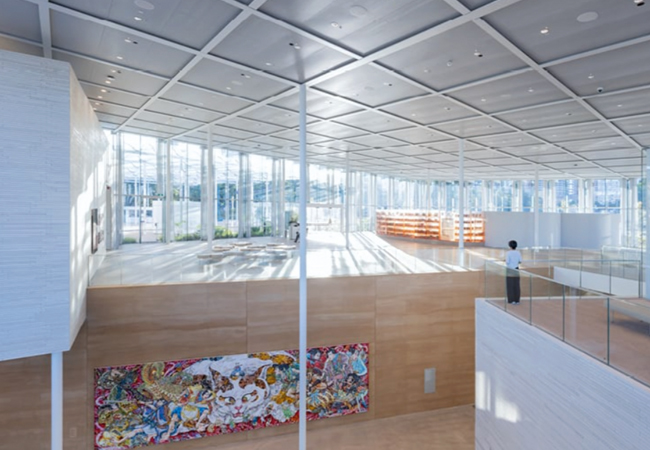
Arup’s recent collaboration with design architect SANAA and executive architect Architectus, the 6-star Green Star design-rated Sydney Modern extension to the Art Gallery of NSW, has conventional wet sprinklers to back-of-house spaces, and pre-action sprinklers installed throughout the galleries and artstorage areas (© Art Gallery of New South Wales, Iwan Baan)
Public museums must be safe for their staff and visitors, as well as for the valuable collections of artworks, artefacts and sculptures they hold. Fire protection systems have a major role to play in keeping these buildings, their contents and occupants protected.
Given the complex and bespoke nature of museums, there is no ‘one size fits all’ approach to designing active fire-suppression systems. The design is usually a collaboration between the fire services and fire safety engineers, architect, structural engineer and the wider design team. It is often performance-based and outside the ‘deemed to satisfy guidance’ of regulatory standards, which do not cater for each and every condition.
Sprinkler systems should be the starting point for active fire suppression in buildings. They are proven to control fires and have done for more than a century. Globally, however, the common view of museum operators and their art-lending teams is that wet services in art spaces should be avoided. In a survey Arup conducted of 16 Australian museums built in the past 25 years, nine (around 56%) were protected with sprinklers, while seven (around 44%) were not. Of those that were protected, only four (around 45%) were required to be by the Australian National Construction Code.
Concern over sprinklers are born of a misconception that activation typically results in a deluge, drenching the whole room and its contents. It is incumbent on the design team to guide museum clients and stakeholders about the actual risks.
US studies suggest that false activation of sprinkler heads occurs at a rate of around one in 16 million heads annually. Assuming a sprinkler head is accidentally damaged and discharges 70 litres per minute (typical AS2118.1 light-hazard sprinkler flowrate suitable for museums with low combustible loading) in a gallery space for 10 minutes – allowing facilities management to investigate and isolate the sprinkler system – this would result in 700 litres of water in the gallery.
If the gallery floor area is 2,000m2, this water will pond around 350mm off the floor, well below the typical wall art hanging height. Of course, there are other considerations, such as how the water will be removed from the gallery and the risk of it draining into areas adjacent and below the flooded space.
Should permanently charged wet pipework still cause concern, double-knock pre-action systems are a sound alternative, where the pipework within the space is charged with nitrogen or an inert gas, with an electrically latched valve requiring both the fire detection system and a sprinkler head to be activated simultaneously to discharge water into the space, thereby reducing the risk of false activation through physical damage.
These systems do introduce some challenges in museum buildings. Code (and good practice) requires a gradient on the pipework to permit proper drain down of the system to remove moisture and reduce risk of pipework corrosion. Coordinating this requirement can be a challenge in gallery spaces that are heavily serviced at ceiling level, have restricted ceiling zones, and with constantly changing exhibits.
Hybrid water mist and nitrogen systems are an exciting development in fire-suppression technology and should be considered owing to their significant reduction in water discharge. This technology is relatively new, however, and not yet permitted by building codes as a ‘DTS’ solution in spaces with high ceilings and air change rates typically found in modern galleries.
These systems also introduce additional controls and valving, meaning more single points of failure.
The high upfront and ongoing costs of gaseous suppression systems often don’t make economical or environmental sense for large gallery spaces, but do have a place in art-storage areas, where collections are often stored in high-density art racks. These rooms have close environmental controls commensurate with the sensitivity of the items they house. Accidental or intended sprinkler discharge in these rooms can have catastrophic outcomes – a small electrical fire setting off one sprinkler at 70 litres per minute in a 50m2 space would drench the room and its contents.
Hybrid water mist and nitrogen systems should be considered for art-storage spaces. due to their significant reduction in water discharge. Shielding or enclosed racking can be useful, but there needs to be hydraulic and fire engineering analysis to validate the effectiveness of the overall solution.
The optimal outcome for each gallery and art-storage space will be informed not only by local building regulations, but also by maintainability, upfront and ongoing costs, environmental impacts and a thorough understanding of how each space will be used over the building’s life.
About the author:
Jake Cherniayeff is Arup Australasia hydraulic and fire services skills leader
